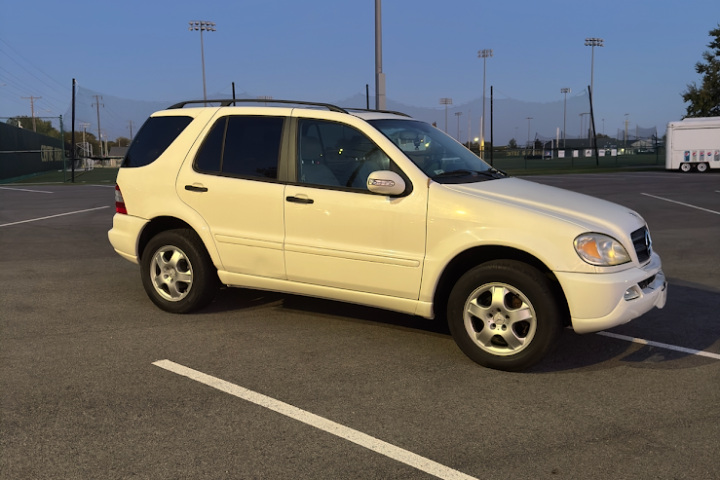by Connor Parks
2005 Mercedes-Benz ML350, owned by Benjamin Dickinson
Want to see your ride featured? Feel free to submit it by contacting connor.parks@centre.edu.
When it comes to marketing a proper luxury SUV, most modern designers have strayed from the category’s original guiding principle: presence is EVERYTHING. Looking at the first-generation Mercedes ML350, it’s evident why. You don’t even have to know what this car is–just one glance and you know there’s power and prestige behind the sleek exterior. The sloped roofline, the rounded edges, the wide base: this is an imposing, powerful, German machine that means business. In an age of ubiquitous, bland coupe-SUVs and uninspiring trim packages, I’ve always looked up to this original class of luxury SUVs as bold precedent-setters for one of today’s favourite market segments. When the opportunity arose to review one for the Cento, then, I jumped on it as quickly as possible.
Ben’s history with his 2005 ML350 began a few years ago in his central Kentucky hometown, when he bought it from a local Vietnam veteran. It had around 220,000 miles when bought, with some 6,300 added to it since purchase. Most of the original miles were accumulated by the car’s first owner: a soccer coach who bought it from Mercedes of Nashville and frequently used it to travel for games. The engine bay, accessible by pulling on the big Mercedes logo on the grille, revealed a brand new battery. When I asked Ben about this, he said the original one (recently replaced after dying during a stint out of state) had been locked in a “cage” and was only accessible through a third party coming to open it up. Other features under the hood included a huge coolant reservoir on top of the engine and a small wooden stick thrown in by a previous owner to be used in lieu of a hood strut.
The ML’s interior provided some of the coolest features I’ve seen on any car I’ve reviewed. Up front, both the driver and passenger seat are controlled electronically and have multiple lumbar memory settings. Ben’s example included light grey leather seats (incredibly comfortable) and plastic across the dashboard and doors–a nice, classy plastic that fit the vehicle well. The infotainment system is very advanced for a 20-year-old car, and even requires a “security code” for access: one of the most German elements I’ve ever seen on a car (along with the Mercedes logo on the gear knob). Ben noted that the AC system worked well with regularly applied coolant. The system functions with three dials on the lower part of the dash: one for intensity, one for temperature, and a middle one neither of us could figure out. The mirrors include blindspot circles and electronically fold all the way in. Other features include a “low range” mode for fuel-savvy driving, SOS call and roadside assistance buttons on the overhead panel, and window switches in the center console instead of on the doors. The glovebox was incredibly small, but Mercedes made up for it by including spacious lockable safes underneath both front seats, something which completely blew me away.
The rear seat and trunk area proved just as interesting. Due to the ML’s unique shape, the rear seats are much taller than the slightly cramped front end, and just as comfortable. The cupholders, window switches, and AC controls are on the center console panel instead of on the doors and in the central armrest. The C-pillar windows are also able to be cracked open manually from the rear seats, or by control up front, a cool little feature I normally associate with more “rugged” outdoor models. In the trunk, space was more than ample and could fit just about anything you’d want to carry, especially with easy-reclining rear seats. Interestingly, the tailgate included small panels that held the first aid kit and a roadside security detail, another hallmark of the ML’s German origins. By far the coolest thing in the trunk, though, was a separate factory CD player tucked behind one of the side panels, which could be pulled out and used by rear seat passengers separately from the front radio.
When it came to the drive, the ML proved surprising in a few areas. Notably, I had expected the 3.7 Litre V6 (producing 223 horsepower) & 5-speed automatic to zip up to speed on straightaways: this was a Mercedes, after all. The reality ended up being a much more moderate acceleration than I’d expected for a German luxury car. It wasn’t slow, but it definitely took a bit more time than I’d hoped to hit the 65 mph. mark. Regardless, it performed well, and at any speed it felt exactly like what the odometer read out. The braking could be lenient but was firm when necessary. Surprisingly, the gas mileage (shown digitally on an overhead panel) was around 14 mpg city and 18 highway, though Ben suggested it regularly measured lower. For this gas-thirsty larger-SUV segment, one could call these numbers enviable. Ride comfort was excellent, and one of the best I’ve noted–the leather seats coddle you as a constant reminder of the car’s luxury heritage.
In short, it’s hard to find many downsides to owning and maintaining a mid-2000s ML350 aside from potential right-to-repair concerns in the engine bay & electronics. Well-kept, high mileage MLs from this generation are fairly easy to find for under $8,000, a relative bargain considering all the “2000s rich” features Mercedes throws in. The decline of the “real” ML series, starting strong in 1998 and ending quietly in 2015, is a real shame in the SUV world. Along with the revolutionary BMW X5 and Porsche Cayenne, it was one of the first sport SUVs to create one of the world’s most popular categories to this day. Though its successor (the GLE series) still sells well, the original ML’s design will forever prove iconic for a fantastic sports SUV full of appealing features: and one I would highly recommend for the price!

